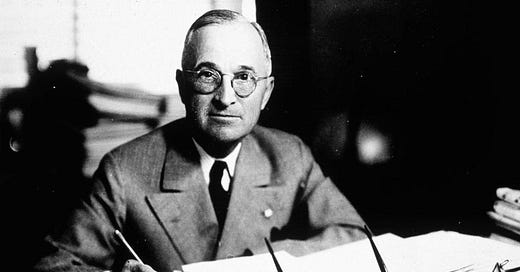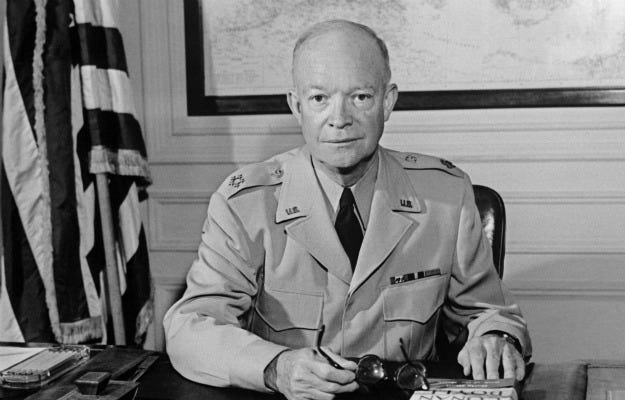Countdown to Hiroshima, 1945
Final plans in place, but what about alternatives? And why did General Eisenhower criticize use of bomb?
Greg Mitchell is the author of a dozen books, including “Hiroshima in America” (with Robert Jay Lifton),“Atomic Cover-up,” and “The Beginning or the End: How Hollywood—and America—Learned to Stop Worrying and Love the Bomb.” He has directed documentary films since 2021, including three for PBS (one of them the award-winning “Atomic Cover-up”). You can still subscribe to this newsletter for free.
Every year at this time, I trace the final days leading up to the first (and so far only) use of the atomic bomb against cities, Hiroshima and Nagasaki, Japan, in August 1945, over at my venerable Pressing Issues blog. I call it Countdown to Hiroshima, though it continues on to Nagasaki, of course, This is a subject that I have studied and written about in hundreds of articles and three books with a special emphasis on the aftermath of the bombings, and the government and media suppression in the decades after. (See my new book, The Beginning or the End: How Hollywood--and America--Learned to Stop Worrying and Love the Bomb.) You can see the entire series, which runs for three weeks, over at Pressing Issues, but here are samples covering four days at the end of July….in 1945.
July 27, 1945
Truman continued to meet with Allied leaders in Germany, as the Soviets got ready to declare war on Japan around August 8 ("fini Japs" when that happened, even without the bomb, Truman had written in his diary this week).
"A Petition to the President of the United States" organized by famed nuclear scientist Leo Szilard, and signed by dozens of his Manhattan Project colleagues -- the only real pre-Hiroshima protests by insiders -- urgently urging delay or extreme caution on the use of the new weapon against Japan, continued to be held in limbo and kept from the President's eyes while Truman remained abroad.
Preparations at Tinian in the Pacific to get the first A-bomb ready for use, possibly within a week (weather permitting) were finalized, with the city of Hiroshima remaining as #1 target. It has been barely touched by Allied bombing so it would serve as the best site to judge the bomb's experimental effects. Also it is nearly surrounded by hills, promising a "focusing effect" (as the target committee boasted) that will likely guarantee killing tens of thousands. Kokura was target #2 and Nagasaki #3, with the bomb on an assembly line process with no need for a separate order for the second and third bombs, which would doom, in the end, Nagasaki.
The Japanese government today released an edited version of the "unconditional surrender" Potsdam declaration (which did not mention the atomic bomb) to their press and citizens, but had not yet rejected it. The Domei news agency had already predicted that the surrender demand "would be ignored." The U.S, after use of bomb, would later accept conditional surrender -- with Japan allowed to keep its emperor -- yet call it unconditional.
Eleven days after the first, and quite secret, atomic test at Trinity, which spread wide clouds of radioactive fallout over residents downwind -- livestock had been sickened or killed -- radiation experts had become concerned about the exposure for one family, the shape of things to come.
July 28, 1945
--Two days after receiving it, the Japanese leadership rejected the Potsdam declaration calling for their "unconditional" surrender, or seemed to. The official word was that it would ignore the demand mokusatsu, or "with silence." Another translation, however, is "to withhold comment." This not-quite-rejection has led some historians to suggest that the U.S. should have pursued the confusing Japanese peace feelers already circulating, especially with suggestions that unconditional terms were the main, or perhaps only, obstacles.
--Secretary of the Navy James V. Forrestal had breakfast with Truman at Potsdam. He had flown there at least partly to press the president to pursue Japanese peace feelers--especially concerning letting them keep their emperor--before using the bomb and killing countless civilians.
--U.S. Ambassador to Moscow Joseph Davies wrote in his diary that Secretary of State James Byrnes was overly excited by the success of the bomb test vis-a-vis future relations with our allies, the Soviets: "Byrnes' attitude that the atomic bomb assured ultimate success in negotiations disturbed me more than his description of its success amazed me. I told him the threat wouldn't work, and might do irreparable harm."
--Four days earlier, Byrnes aide Walter Brown had written in his diary that Byrnes' view was that "after atomic bomb Japan will surrender and Russia will not get in so much on the kill." The Soviets were scheduled to enter the war on August 7 (which likely would have prompted a Japanese surrender, even without use of the Bomb), so there was some urgency.
On July 29, 1945:
—Truman wrote letter to wife Bess from Potsdam on dealings there (but does not mention A-bomb discussions with Soviets): “I like Stalin. He is straightforward, knows what he wants and will compromise when he can’t get it. His Foreign Minister isn’t so forthright.“ Truman casually informed Stalin about the atomic bomb but no one is quite certain that the latter understood.
—Japanese sub sinks the U.S.S. Indianapolis, killing over 800 American seamen. If it had happened three days earlier, the atomic bomb the ship was carrying to Tinian would have never made it.
—A Newsweek story observes: “As Allied air and sea attacks hammered the stricken homeland, Japan’s leaders assessed the war situation and found it bordering on the disastrous…. As usual, the nation’s propaganda media spewed out brave double-talk of hope and defiance.” But it adds: “Behind the curtain, Japan had put forward at least one definite offer. Fearing the results of Russian participation in the war, Tokyo transmitted to Generalissimo Stalin the broad terms on which it professed willingness to settle all scores.”
—Assembling of the first atomic bomb continued at Tinian. It would likely be ready on August 1 and the first use would be dictated by the weather. The second bomb—the plutonium device—was still back in the States. The target list, with Hiroshima as #1, remained in place, although it was being studied for the presence of POW camps holding Americans in the target cities.
—Secretary of War Stimson began work on the statement on the first use of the bomb that President Truman would record or release in a few days, claiming we merely hit a "military base," assuming the bomb worked.
July 30, 1945
—Gen. Dwight D. Eisenhower, commander of U.S. troops in Europe, has visited President Truman in Germany, and would recall what happened in his memoir (Mandate for Change): "Secretary of War Stimson, visiting my headquarters in Germany, informed me that our government was preparing to drop an atomic bomb on Japan. I was one of those who felt that there were a number of cogent reasons to question the wisdom of such an act...
"During his recitation of the relevant facts, I had been conscious of a feeling of depression and so I voiced to him my grave misgivings, first on the basis of my belief that Japan was already defeated and that dropping the bomb was completely unnecessary, and secondly because I thought that our country should avoid shocking world opinion by the use of a weapon whose employment was, I thought, no longer mandatory as a measure to save American lives. It was my belief that Japan was, at that very moment, seeking some way to surrender with a minimum loss of 'face'. The Secretary was deeply perturbed by my attitude..."
In a Newsweek interview, Ike would add: "...the Japanese were ready to surrender and it wasn't necessary to hit them with that awful thing." And for another thing, Russia was about to declare war on Japan and Truman had just written in his diary, "Fini Japs" when that happened, even without the Bomb.
-- Stimson, now back at the Pentagon, cabled Truman, that he had drafted a statement for the president that would follow the first use of the new weapon--and Truman must urgently review it because the bomb could be used as early as August 1. Stimson sent one of his aides to Germany with two copies of the statement. The top secret, six-page typed statement opened: "____ hours ago an American airplane dropped one bomb on ______ and destroyed its usefulness to the enemy. That bomb has more power than 20,000 tons of TNT.... It is an atomic bomb. It is a harnessing of the basic power of the universe." Later, as we will see, the claim that Hiroshima was merely "a military base" was added to the draft.
--After scientists sifted more data from the July 16 Trinity test of the first weapon, Gen. Leslie R. Groves, military head of the Manhattan Project provided Gen. George Marshall, our top commander, with more detail on the destructive power of atomic weapons. Amazingly, despite the new evidence, Groves recommended that troops could move into the "immediate explosion area" within a half hour (and, indeed, in future bomb tests soldiers would march under the mushroom clouds and receive harmful doses of radiation). Groves also provided the schedule for the delivery of the weapons: By the end of November more than ten weapons would be available, in the event the war had continued.
--Groves faced a new problem, however. Gen. "Tooey" Spaatz on Guam urgently cabled that sources suggested that there was an Allied prisoner of war camp in Nagasaki just a mile north of the center of the city. Should it remain on the target list?" Groves, who had already dropped Kyoto from the list after Stimson had protested, refused to shift. In another cable Spaatz revealed that there were no POW camps in Hiroshima, or so they believed. This firmed up Groves's position that Hiroshima should "be given top priority," weather permitting. As it turned out, POWs died in both cities from the bombing.







For several years, I have attended a service to commemorate the first use of the bomb on Hiroshima, organized by the Princeton Coalition for Peace Action. When I am unable to go, I make a point of rereading John Hersey’s book. Early August always weighs heavy on my heart.